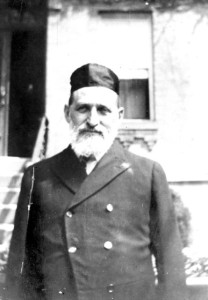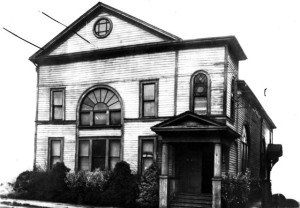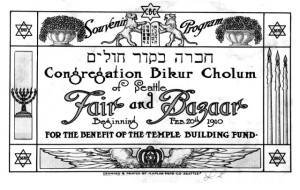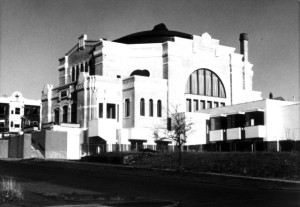Chevra Bikur Holim
In 1880, 145 Jews lived in the Washington territory.
There was no official synagogue, nor was there a Jewish cemetery.
Services were held in Jacob Alpern’s store on Front Street.
Jewish holidays often were celebrated in rented rooms and the deceased were shipped to Victoria, British Columbia for burial.
In 1889, Chevra Bikur Holim was founded in Seattle and officially became incorporated in 1891.
A plot of land at Oak Lake Cemetery was purchased, in 1890, for Jewish burials.
Dr. B. Myers and Aaron Garfinkle served as the first president and vice-president, respectively, in 1891.
The first rabbi, though unofficial in title and salary, was Rabbi Hirsh Genss, who began his service to Bikur Holim in 1889, as a schochet (ritual slaughterer), mohel (circumciser), and rabbi.
The First Building — 1898
Until 1897, religious services were held in rented rooms and tents, such as the Hinkley Block on Second Avenue and Columbia Street, and “Seattle Central” on Fifth Avenue and Washington Street.
In 1898, when it became clear that the Jews of Seattle needed a more permanent place of worship, they purchased a property at 13th and Washington.
The house was remodeled so that it consisted of one large room with space for 120 seats and a balcony for the women with space for 80 seats.
For Rosh Hashanah services in 1898, the new synagogue was too small to hold all the congregants, so they rented Morris Hall at Broadway and Yesler for additional space.
In 1889, the Talmud Torah (school) was located in the Seattle Central Building at 5th and Washington.
By 1900, Bikur Holim members had constructed a permanent structure on the lot next door to the synagogue house at 13th and Washington.
The first mikvah (ritual bath) was located in the basement of Zalman Grozinsky’s home at 1217 South Washington Street.
Bikur Holim officially became a congregation in 1900.
Annual membership cost 75 cents, and High Holiday tickets were $2.50 each.
In 1909, the Ladies’ Auxiliary was founded. Their fundraising efforts were responsible for the gold and white aron kodesh (ark for the Torah), complete with electric lights.
In 1916, the building was sold to another congregation: Sephardic Bikur Holim.
The Second Building – 1910
In 1909, Bikur Holim purchased a new synagogue at 17th and Yesler for $15,000.
Construction on the lower floor was completed in time for the 1910 Rosh Hashanah services, though the congregation still held overflow services at the original synagogue location.
In 1912, Chevra Bikur Holim purchased additional cemetery plots.
In 1913, B. Marcus Priteca, a Seattle architect who also created the coliseum, opera house, and Orpheum Theatre, designed the synagogue at 17th and Yesler, dedicating it in 1915.
In 1913, the Talmud Torah was located at 18th and Fir.
Un 1917, it was moved to the vestry of the building on 17th and Yesler.
During World War I, the Jewish population of Seattle grew due to a rise in Russian immigration to the Pacific Northwest.
In 1918, Rabbi Simon Glazer of Montreal became rabbi of Chevra Bikur Cholim.
In 1919, a kashrut (kosher certifying)committee was appointed to supervise the purchase and distribution of kosher meat.
From 1920-21, a mikvah building was completed, located at 18th Avenue and Spruce Street.
In 1924, the choir was led by Al Hoffman, who went on to compose popular music.
Also in 1924, Bikur Holim purchased additional lots at 12th and Spruce.
In 1930, B. Marcus Priteca designed the new school, built on property purchased at 25th and Columbia.
In 1932, the Hachnos Orchim Society was founded to assist Seattle Jews affected by the depression.
In 1939, the society worked to help German Jews fleeing from the Nazis. The society also built a synagogue library that year.
From 1941 to 1951, Bikur Holim supported soldiers traveling to nearby military posts.
In 1958, a summer camp was established for the congregation’s children.
Due to the changing neighborhood demographics, the board voted to sell the Yesler and 17th synagogue building in 1967, holding their last services there in 1970.
This synagogue building (including the mikvah) is now the Langston Hughes Cultural Arts Center.
The Yavneh Branch – 1967
As congregants moved to Seward Park, they began holding services at a house in their new neighborhood, an auxiliary to the Yesler synagogue.
As the population grew, they moved to Ezra Bessaroth Congregation’s downstairs social hall.
In 1967, the Yavneh Branch of Bikur Holim built a new building on the grounds of the Ezra Bessaroth Congregation.
Another auxiliary minyan (prayer quorum) was created on Capitol Hill in the Temple De Hirsch building.
The Third Building – 1971
Construction for the third building of Bikur Holim began in 1971 at 5145 South Morgan Street.
A new mikvah was built in 1970 in Seward Park, a joint project funded by Chevra Bikur Holim, Ezra Bessaroth and Sephardic Bikur Holim.
In 1971, Bikur Holim merged with Congregation Machzikay Hadath, calling themselves Bikur Holim Machzikay Hadath.
In 1971, the congregants brought the original aron kodesh from the Yesler building and installed it in the Seward Park synagogue.
The sisterhood’s fundraising efforts provided for the installation of stained glass windows of the twelve tribes on the walls.
Rabbi Moses Londinski became the Rabbi of the new congregation in 1972.
A fire in 1981 caused minimal damage.
Source
- Metta Buttnick, “Congregation Bikur Holim-Machzikay Hadath of Seattle: The Beginning Years,” Western States Jewish History 22/2.
Samantha Silver is curator for this Chevra Bikur Holim exhibit.



![Congregation Bikur Cholim-Seattle,WA [19105]^Dedication Invitation, #WS0178](http://www.jmaw.org/wp-content/uploads/2013/10/WS0178-2-R-Cong_-Bikur-Cholim-SeattleWA-19105-210x300.jpg)

